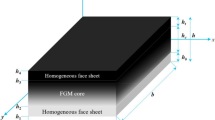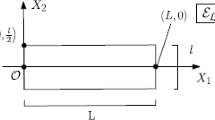Abstract
The present paper can be considered as an extension of the work (Charalambopoulos and Polyzos in Arch Appl Mech 85:1421–1438, 2015). The simplest possible elastostatic version of Mindlin’s strain gradient elastic (SGE) theory is employed for the solution of a SGE rectangle in bending under plane strain conditions. The equilibrium equations as well as expressions for all types of stresses and boundary conditions appearing in the considered rectangle are explicitly provided. An improved version of Mindlin’s solution procedure via potentials is proposed. Besides, an elegant solution representation that contains the solution of the corresponding classical elastic problem is demonstrated. Results of six plane strain bending problems, which reveal a significant diversification from the classical elasticity theory and specific features of the underlying microstructure, are addressed and discussed.












Similar content being viewed by others
References
Exadaktylos, G.E., Vardoulakis, I.: Microstructure in linear elasticity and scale effects: a reconsideration of basic rock mechanics and rock fracture mechanics. Tectonophysics 335, 81–109 (2001)
Polyzos, D., Fotiadis, D.I.: Derivation of Mindlin’s gradient elastic theory via simple lattice and continuum models. Int. J. Solids Struct. 49, 470–480 (2012)
Mindlin, R.D.: Micro-structure in linear elasticity. Arch. Ration. Mech. Anal. 16, 51–78 (1964)
Mindlin, R.D.: Second gradient of strain and surface-tension in linear elasticity. Int. J. Solids Struct. 1, 417–438 (1965)
Toupin, R.A.: Elastic materials with couple-stresses. Arch. Ration. Mech. Anal. 11, 385–414 (1962)
Polyzos, D., Tsepoura, K.G., Tsinopoulos, S.V., Beskos, D.E.: A boundary element method for solving 2D and 3D static gradient elastic problems, Part 1: integral formulation. Comput. Methods Appl. Mech. Eng. 192, 2845–2873 (2003)
Lazar, M., Maugin, G.A.: Nonsingular stress and strain fields of dislocations and disclinations in first strain gradient elasticity. Int. J. Eng. Sci. 43, 1157–1184 (2005)
Gao, X.-L., Park, S.K.: Variational formulation of a simplified strain gradient elasticity theory and its application to pressurized thick-walled cylinder problem. Int. J. Solids Struct. 44, 7486–7499 (2007)
Gourgiotis, P.A., Georgiadis, H.G.: Plane-strain crack problems in microstructured solids governed by dipolar gradient elasticity. J. Mech. Phys. Solids 57, 1898–1920 (2009)
Tekoglu, C., Onck, P.R.: Size effects in two-dimensional Voronoi foams: a comparison between generalized continua and discrete models. J. Mech. Phys. Solids 56, 3541–3564 (2008)
Georgiadis, H.G., Anagnostou, D.S.: Problems of the Flamant–Boussinesq and Kelvin type in dipolar gradient elasticity. J. Elast. 90, 71–98 (2008)
Neff, P., Jeong, J., Ramézani, H.: Subgrid interaction and micro-randomness: novel invariance requirements in infinitesimal gradient elasticity. Int. J. Solids Struct. 46, 4261–4276 (2009)
Froiio, F., Zervos, A., Vardoulakis, I.: On natural boundary conditions in linear 2nd-grade elasticity in mechanics of generalized continua. In: Maugin GA, Metrikine AV (eds), pp. 211–221. Springer, Berlin (2010)
Karlis, G.F., Charalambopoulos, A., Polyzos, D.: An advanced boundary element method for solving 2D and 3D static problems in Mindlin’s strain-gradient theory of elasticity. Int. J. Numer. Methods Eng. 83, 1407–1427 (2010)
Askes, H., Aifantis, E.C.: Gradient elasticity in statics and dynamics: an overview of formulations, length scale identification procedures, finite element implementations and new results. Int. J. Solids Struct. 48, 1962–1990 (2011)
Forest, S., Trinh, D.K.: Generalized continua and non homogeneous boundary conditions in homogenisation methods. ZAMM. Z. Angew. Math. Mech. 91(2), 90–109 (2011)
Forest, S., Sab, K.: Stress gradient continuum theory. Mech. Res. Commun. 40, 16–25 (2012)
Sciarra, G., Vidoli, S.: Asymptotic fracture modes in strain-gradient elasticity: size effects and characteristic lengths for isotropic materials. J. Elast. 113, 27–53 (2013)
Javili, A., dell’Isola, F., Steinmann, P.: Geometrically nonlinear higher-gradient elasticity with energetic boundaries. J. Mech. Phys. Solids 61, 2381–2401 (2013)
Broese, C., Tsakmakis, C., Beskos, D.E.: Mindlin’s micro-structural and gradient elasticity theories and their thermodynamics. J. Elast. 125, 87–132 (2016)
Ojaghnezhada, F., Shodja, H.M.: Surface elasticity revisited in the context of second strain gradient theory. Mech. Mater. 93, 220–237 (2016)
Forest, S.: Nonlinear regularization operators as derived from the micromorphic approach to gradient elasticity, viscoplasticity and damage. Proc. R. Soc. A 472, 20150755 (2016)
Polizzotto, C.: Stress gradient versus strain gradient constitutive models within elasticity. Int. J. Solids Struct. 51, 1809–1818 (2014)
Polizzotto, C.: A note on the higher order strain and stress tensors within deformation gradient elasticity theories: physical interpretations and comparisons. Int. J. Solids Struct. 90, 116–121 (2016)
Polizzotto, C.: A hierarchy of simplified constitutive models within isotropic strain gradient elasticity. Eur J. Mech. A/Solids 61, 92–109 (2017)
Lazar, M., Po, G.: On Mindlin’s isotropic strain gradient elasticity: green tensors, regularization and operator-split. J. Micromech. Mol. Phys. 3(3), 1840008 (2018)
Bleustein, J.L.: Effects of micro-structure on the stress concentration at a sphere cavity. Int. J. Solids Struct. 2, 83–104 (1966)
Cook, T.S., Weitsman, Y.: Strain-gradient effects around spherical inclusions and cavities. Int. J. Solids Struct. 2, 393–406 (1966)
Eshel, N.N., Rosenfeld, G.: Effects of strain-gradient on the stress concentration at a cylindrical hole in a field of uniaxial tension. J. Eng. Math. 4(2), 97–111 (1970)
Eshel, N.N., Rosenfeld, G.: Some two-dimensional exterior problems in a linear elastic solid of grade two, ZAMM- Z. Angew. Math. Mech. 53, 761–772 (1973)
Eshel, N.N., Rosenfeld, G.: Axisymmetric problems in elastic materials of grade two. J. Frankl. Inst. 299(1), 43–51 (1975)
Li, S., Miskioglu, I., Altan, B.S.: Solution to line loading of a semi-infinite solid in gradient elasticity. Int. J. Solids Struct. 41, 3395–3410 (2004)
Anagnostou, D.S., Gourgiotis, P.A., Georgiadis, H.G.: The Cerruti problem in dipolar gradient elasticity. Math. Mech. Solids 20, 1088–1106 (2015)
Gourgiotis, P.A., Zisis, Th, Georgiadis, H.G.: On concentrated surface loads and Green’s functions in the Toupin–Mindlin theory of strain-gradient elasticity. Int. J. Solids Struct. 130–131, 153–171 (2018)
Aravas, N., Giannakopoulos, A.E.: Plane asymptotic crack-tip solutions in gradient elasticity. Int. J. Solids Struct. 46, 4478–4503 (2009)
Gao, X.-L., Ma, H.M.: Solution of Eshelby’s inclusion problem with a bounded domain and Eshelby’s tensor for a spherical inclusion in a finite spherical matrix based on a simplified strain gradient elasticity theory. J. Mech. Phys. Solids 58, 779–779 (2010)
Ma, H.M., Gao, X.-L.: Strain gradient solution for a finite-domain Eshelby-type plane strain inclusion problem and Eshelby’s tensor for a cylindrical inclusion in a finite elastic matrix. Int. J. Solids Struct. 48(2011), 44–55 (2011)
Charalambopoulos, A., Polyzos, D.: Plane strain gradient elastic rectangle in tension. Arch. Appl. Mech. 85, 1421–1438 (2015)
Papargyri-Beskou, S., Tsinopoulos, S.V.: Lame’s strain potential method for plain gradient elasticity problems. Arch. Appl. Mech. 9–10, 1399–1419 (2015)
Khakalo, S., Niiranen, J.: Gradient-elastic stress analysis near cylindrical holes in a plane under bi-axial tension fields. Int. J. Solids Struct. 110–111, 351–366 (2017)
Khakalo, S., Niiranen, J.: Form II of Mindlin’s second strain gradient theory of elasticity with a simplification: for materials and structures from nano- to macro-scales. Eur. J. Mech. A/Solids 71, 292–319 (2018)
Papargyri-Beskou, S., Tsepoura, K.G., Polyzos, D., Beskos, D.E.: Bending and stability analysis of gradient elastic beams. Int. J. Solids Struct.40, 385–400 and 42, 4911–4912 (2003)
Giannakopoulos, A.E., Stamoulis, K.: Structural analysis of gradient elastic components. Int. J. Solids Struct. 44, 3440–3451 (2007)
Kong, S., Zhou, S., Nie, Z., Wang, K.: Static and dynamic analysis of micro beams based on strain gradient elasticity theory. Int. J. Eng. Sci. 47, 487–498 (2009)
Papargyri-Beskou, S., Beskos, D.E.: Static analysis of gradient elastic bars, beams, plates and shells. Open Mech. J. 4, 65–73 (2010)
Lazopoulos, K.A., Lazopoulos, A.K.: Bending and buckling of thin strain gradient elastic beams. Eur. J. Mech. A/Solids 29, 837–843 (2010)
Wang, B., Zhao, J., Zhou, S.: A micro scale Timoshenko beam model based on strain gradient elasticity theory. Eur. J. Mech. A/Solids 29, 591–599 (2010)
Xia, W., Wang, L., Yin, L.: Nonlinear non-classical microscale beams: static bending, postbuckling and free vibration. Int. J. Eng. Sci. 48, 2044–2053 (2010)
Akgöz, B., Civalek, Ö.: Analysis of micro-sized beams for various boundary conditions based on the strain gradient elasticity theory. Arch. Appl. Mech. 82, 423–443 (2012)
Giannakopoulos, A.E., Petridis, S., Sophianopoulos, D.S.: Dipolar gradient elasticity of cables. Int. J. Solids Struct. 49, 1259–1265 (2012)
Amiot, F.: An Euler–Bernoulli second strain gradient beam theory for cantilever sensors. Philos. Mag. Lett. 93(4), 204–212 (2013)
Challamel, N.: Higher-order shear beam theories and enriched continuum. Mech. Res. Commun. 38, 388–392 (2011)
Challamel, N.: Variational formulation of gradient or/and nonlocal higher-order shear elasticity beams. Compos. Struct. 105, 351–368 (2013)
Triantafyllou, A., Giannakopoulos, A.E.: Structural analysis using a dipolar elastic Timoshenko beam. Eur. J. Mech. A/Solids 39, 218–228 (2013)
Eltaher, M.A., Hamed, M.A., Sadoun, A.M., Mansour, A.: Mechanical analysis of higher order gradient nanobeams. Appl. Math. Comput. 229, 260–272 (2014)
Jafari, A., Ezzati, M.: Investigating the non-classical boundary conditions relevant to strain gradient theories. Physica E 86, 88–102 (2017)
Gortsas, T., Tsinopoulos, S.V., Rodopoulos, D., Polyzos, D.: Strain gradient elasticity and size effects in the bending of fiber composite plates. Int. J. Solids Struct. 143, 103–112 (2018)
Selvadurai, A.P.S.: Partial Differential Equations in Mechanics 2. Springer, Berlin (2000)
Author information
Authors and Affiliations
Corresponding author
Additional information
Publisher's Note
Springer Nature remains neutral with regard to jurisdictional claims in published maps and institutional affiliations.
Appendix A
Appendix A
This appendix deals with the proof of Theorem 1 stated in Section 4 of the present work.
We consider the vector Helmholtz decomposition of the displacement vector, i.e.,
Inserting (A.1) into (24), one obtains
Defining as
Equation (A.2) is simplified to
From (A.3) and (A.4), we obtain the relations
In the sequel, taking the inner product of Eq. (A.4) with the position vector \(\mathbf{r}\), utilizing the identity \(\nabla ^{2}\left( {\mathbf{r}\cdot \mathbf{a}} \right) =\mathbf{r}\cdot \nabla ^{2}{} \mathbf{a}+2\nabla \cdot \mathbf{a}\) and making use of Eq. (A.5), one yields
Applying the operator \(\left( {1-g^{2}\nabla ^{2}} \right) \) on Eq. (A.7) and taking into account Eq. (A.6), Eq. (A.7) is transformed to
Making use of the identity
Eq. (A.8) reads
with
Finally, starting from Eq. (A.1) we have the following algebra
Equation (A.12) in conjunction with (A.4) and (A.10) readily shows the validity of the present theorem 1.
Rights and permissions
About this article
Cite this article
Charalambopoulos, A., Tsinopoulos, S.V. & Polyzos, D. Plane strain gradient elastic rectangle in bending. Arch Appl Mech 90, 967–986 (2020). https://doi.org/10.1007/s00419-019-01649-3
Received:
Accepted:
Published:
Issue Date:
DOI: https://doi.org/10.1007/s00419-019-01649-3




